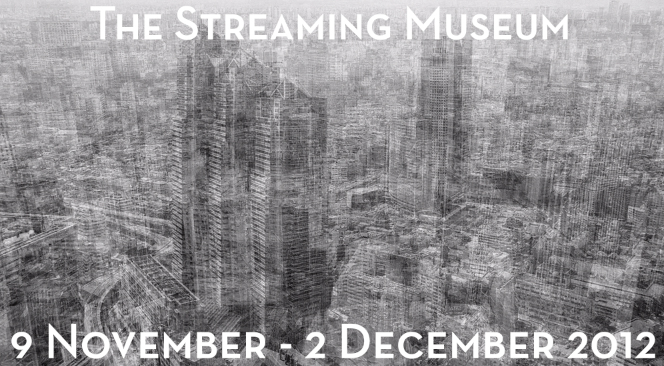THE STREAMING MUSEUM
MOMENTUM is proud to host 5 video programs curated by
New York City’s STREAMING MUSEUM
Featuring 29 digital and video artworks by 22 artists from around the world.
9 November – 2 December 2012
The Streaming Museum has presented over 30 video exhibitions since its launch on January 29, 2008 that have been viewed by millions of people on public screens in over 55 cities and Antarctica. Produced and broadcast in New York City, Streaming Museum generates its dynamic, innovative content of international fine arts, culture and visionary innovations in collaboration with prominent and emerging visual and performing artists and curators. The museum also presents exhibitions and events at partnering cultural centers and international arts festivals. The selection presented at MOMENTUM | Berlin features video programs curated for the ZERO1 Biennale in California and other international art festivals. We are featuring 5 Streaming Museum programs including 23 artists from around the globe.
REVELATION
JEREMY BLAKE – Chemical Sundown (2001); Station to Station: Indiglo Heights (#5), (2001); Winchester Redux (2004)
JENNY MARKETOU – Levels of Disturbance (2009 – 2011)
YORGO ALEXOPOULOS – No Feeling is Final (2010)
MARTY ST. JAMES – Oneiric (2001); The Invisible Man (2007)
CYBORG ALARM, curated by Tanya Toft
KAROLINA SOBECKA – Capacity to Act in a World (2011)
MICHAEL GREATHOUSE – In Dreams (2009)
SOPHIE KAHN – 04302011 (2011)
JAMES CASE-LEAL – Republic of Heaven (2010)
JASON BERNAGOZZI – The Presence of Something in its Absence (2008)
CARABALLO-FARMAN – Venerations (Applause) (2009)
KAIROS
EMANUEL DIMAS DE MELO PIMENTA – Kairos (2011)
WE WRITE TO YOU FROM THE DISTANT FUTURE
MICHAEL NAJJAR – Bionic Angel (2006)
MITCHELL JOACHIM/TERREFORM ONE – Jetpack Packing (2010); Blimp Bumper Bus (2008); Fab Tree Hab Village (2009); Rapid Re(F)Use (2008); Green Brain: A Smart Park For A New City (2006)
EDUARDO KAC – Lagoglyphs (2009)
ETOY – Mission Eternity (2005 – 2016)
ANDREA ACKERMAN – Rose Breathing (2003)
JOHN SIMON, JR. – HD Traffic (2009)
ARTISTIC LICENSE IN SILICON VALLEY (Concurrently being shown at the ZERO1 Biennale)
MICHAEL NAJJAR – The Invisible City (2004)
SOPHIE KAHN – 04302011 (2011)
MAURICE BENAYOUN – Emotion Forecast (2010)
SCOTT DRAVES – Gen 244 (2011)
MULTI-TOUCH BARCELONA – HI, A Real Human Interface (2009)
URSULA ENDLICHER – Facebook Re-enactments (2009)
MARK AMERIKA – #New Aesthetic Video (2012)
More information about each program below:
ARTISTIC LICENSE IN SILICON VALLEY
Streaming Museum launched its fall exhibition Artistic License in Silicon Valley at the ZERO1 Biennial Urban Screen, San Jose, California, on September 14. The Biennial runs through December 8. The exhibition features seven internationally known artists: Michael Najjar, Sophie Kahn, Maurice Benayoun, Scott Draves, Multi-touch Barcelona, Ursula Endlicher, and Mark Amerika. The Urban Screen program has been commissioned by ZERO1 and the San Jose Public Art Program with support from the National Endowment for the Arts.
Artistic License in Silicon Valley is an exhibition for screens presenting unique perceptions of technology in global digital culture created by internationally known contemporary artists.
Streaming Museum @ ZERO1 Biennial

#NewAestheticVideo (2012) by Mark Amerika
This mock trailer for a movie that was never made but lives on the Web as a distributed narrative, refers to an eponymous artist whose artistic presence and remixed persona is a mashup of mobile phone videos, animated gifs, Google Earth glitch imagery, and the corrupting presence of a literary voice summoned from the digital-beyond.

Emotion Forecast (2010) (Video Version) by Maurice Benayoun
This real-time data visualization artwork depicts the Internet as the nervous system of the world by measuring 48 emotions on websites related to current events in more than 3200 cities worldwide, revealing the results in a hyperactive map.

Gen 244 (2011) by Scott Draves
Artificial intelligence and human designers come together in this generative, participatory “cloud art” work made with mathematics and Darwinian evolution by Draves’ Electric Sheep open source code. The essence of life is created in digital form in the artwork’s cyborganic mind comprised of 450,000 computers and people who vote on their favorite designs which reproduce according to a genetic algorithm.

Facebook Re-enactments (2009) (Video Version) by Ursula Endlicher
The artist bridges the gap between the Internet, physical reality and performance, impersonating people who share the same name on Facebook.

04302011 (2011) by Sophie Kahn
Laser portraits that appear incomplete and fragmented as a result of disruptions caused by the models’ movement and breathing during the scanning process, suggest a metaphor of instability in our digitally mediated identities.

HI, A Real Human Interface (2009) by Multi-touch Barcelona
This film imagines the concept of personal computer quite literally as possessing life-like qualities of human companions, by embedding a human being inside of one.

The Invisible City (2004) by Michael Najjar
Sensory fluid imagery of the megacities New York, Mexico City, São Paulo, Paris, Berlin, London, Shanghai, and Tokyo explores telematic space and the future development of global cities as the material embodiment of information density.
WE WRITE TO YOU FROM THE DISTANT FUTURE

Streaming Museum’s fall 2010 exhibition featured at Zero One San Jose Biennial, Tina b. Prague Contemporary Art Festival, the Big Screen Project NYC, and throughout its global network of screens in public spaces.
We Write This To You From the Distant Future is a multi-media exhibition of work by visionary creators in the arts and sciences that focuses on a future world imagined and possible to build.

The exhibition title is a line spoken by the narrator in Immobilité (2009), a 75-minute feature length art film shot with a mobile phone video camera by Mark Amerika, with music score by Chad Mossholder. A remix collection from Immobilité opens the exhibition evoking questions – how will a technologically advanced world effect what it is to be human and what is the world with advanced technology to become?
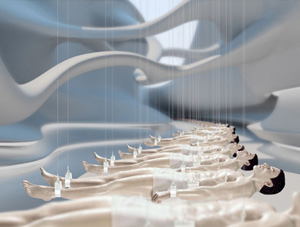
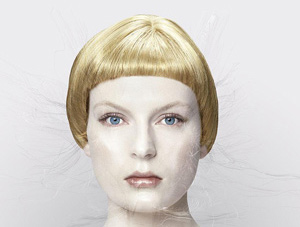
In Michael Najjar’s bionic angel (2006) series (courtesy, bitforms gallery, NYC), creatures in the throes of transformation are a metaphor for inevitable genetic self-creation and possible immortality of the human body.
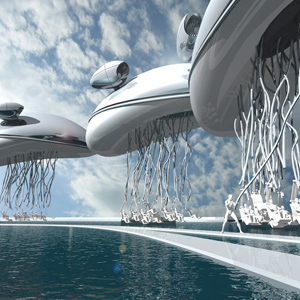
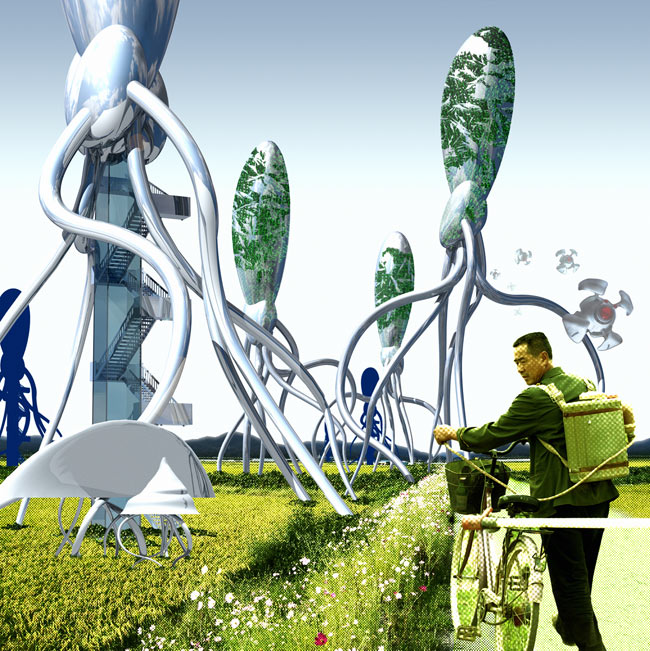
Mitchell Joachim/Terreform ONE, imagines human adaptation to global climate shifts and designs for transportation, habitat and sustainable living in the urban environment in Jetpack Packing, (2010); Blimp Bumper Bus, (2008), Fab Tree Hab Village, (2009), Rapid Re(F)Use, (2008); Green Brain: A Smart Park For A New City, (2006). View these images here.
Eduardo Kac animates a poetic code/language in Lagoglyphs (2009) that defies interpretation but derives meaning from his bio artwork, Alba (2000), a genetically engineered bunny.
Etoy’s Mission Eternity (2005 – 2016) is a digital cult of the dead for the information society that crosses the boundaries of the afterlife, and challenges the way human civilization deals with memory (conservation/loss), time (future/present/past) and death.
Rose Breathing (2003), an undulating cross-species rose, creates a Zen-like meditation as it rhythmically opens and closes in time-altered human-like respiration. Artist and scientist Andrea Ackerman has created at the intersection of technology, nature, aesthetics and ethics, a work that prophetically signals the inevitable integration of technology and nature.
HD Traffic (2009) by John F. Simon, Jr., is a software artwork inspired by the compositional style of Piet Mondrian, with particular inspiration from Broadway Boogie Woogie and Simon’s love of jazz improvisation. HD Traffic can react dynamically to real-time information streams taken from the Internet, and reflect the pulse of human movement that is embodied in the flow of traffic and other data.
“Skin has become inadequate in interfacing with reality. Technology has become the body’s new membrane of existence.” (Nam June Paik)
KAIROS
By Emanuel Pimenta
EMANUEL DIMAS DE MELO PIMENTA, Kairos: an architectural design for a building in Earth’s orbit, 2011
This video and sound artwork was created in memory of John Cage, René Berger, Joseph Beuys, Hans Joachim Koellreutter, Richard Buckminster Fuller, Marshall McLuhan and John Archibald Wheeler – seven magical doors to a new universe. The sound art is composed of extraterrestrial sounds and was presented in concert SETI in 2002.
“Human must rise above the Earth – to the top of the atmosphere and beyond – for only thus will he fully understand the world in which he lives” – Socrates (469-399 BC)
“Following Nature’s own design principles, human may be able to produce most-economic designs while at the same time solving formerly insoluble design problems” – Richard Buckminster Fuller
Kairos is an orbital building, a privileged observatory of Earth, open to civil society, recalling the ancient Sumerian concept of ‘deep time’, projecting a complex of human values in a large-scale spectrum. KAIROS is a conceptual work that merges architecture design and art project in a same corpus – a crossing point between aesthetics, function and technology. Being an architectural design, it presents structural developments in terms of function and technological challenges. As a visual artwork, it crosses all fields of environments and functions, projecting unexpected images that are, at the same time, abstract and figurative, linear and non-linear. As an artwork it questions and criticizes the concept of contemporary art and culture in general. In few words, Kairos is a design for an orbital building.
Kairos was launched on September 10, 2011, at Holotopia Academy, Amalfi Coast, where Ulysses met the Sirens in Homer’s Odyssey. The work became a part of the permanent collection at the ancient 17th century tower which was transformed into a contemporary art museum by the scientist and art lover, Alberto del Genio, Founder of the Holotopia Academy which is devoted to music, art and philosophy. On the 27th of October 2011 Kairos was exhibited at the Robotarium technology/art center in Lisbon, Portugal, curated by its founder/director and robotic artist, Leonel Moura. and in November of the same year the book Kairos: A Bird Orbiting Planet Earth was released. It includes details of the project, and a history of space satellites, laboratories and stations.
Pimenta is a Brazilian musician, architect, and intermedia artist. His works have been included in art collections and have been recognized by institutions such as the Whitney Museum of New York, the Ars Aevi Contemporary Art Museum, the Venice Biennale, the Kunsthaus Zürich, the Bibliotèque Nationale of Paris and the MART – Modern Art Museum of Rovereto and Trento among others.
Pimenta develops music, architecture, and urban projects using virtual reality and cyberspace technologies. His concerts of music integrate visual art and have been performed in various countries in the last twenty years, beginning with his concert at the São Paulo Art Biennial, in 1985, with John Cage, Francesco Clemente, Sandro Chia, and Robert Rauschenberg.
Pimenta has collaborated with John Cage, as commissioned composer for Merce Cunningham. He has been composer for several companies such as the Appels Company in New York. His concerts have been performed at the Lincoln Center and The Kitchen in New York, the Palais Garnier, the Shinjuku Bunka Center in Tokyo, the Festival of Aix en Provence, and the São Paulo Museum of Art.
In the early 1980s, Emanuel Pimenta coined the concept “virtual architecture”, later largely used as specific discipline in universities all over the world. Since the end of the 1970s he has developed graphical musical notations inside virtual environments.
He has served as a curator for the Biennial of São Paulo, the Calouste Gulbenkian Foundation, the Triennial of Milan, and the Belém Cultural Center.
Pimenta is a founding member of the International Society for the Interdisciplinary Study of Symmetry. He is member of the jury of the BES Fellowship (Experimental Intermedia Foundation of New York, the Luso American Foundation and the Calouste Gulbenkian Foundation) since 1995. He his director of the contemporary music festival Holotopia, in Naples. He is also founder and director of the Foundation for Arts, Sciences and Technology – Observatory, in Trancoso, Portugal. He was editorial director of the art and culture magazine RISK Arte Oggi from 1995 to 2005. He is also member of the advisory editorial board of the science magazine Forma, in Tokyo, and of the art and philosophy magazine Technoetic Arts, in Bristol, England.
Excerpt from the book “Kairos: A Bird Orbiting Planet Earth”
CYBORG ALARM
When Technology, Imagination and Body Collide
Curated by Tanya Toft, Curatorial Fellow, Streaming Museum
Streaming Museum opened the exhibition CYBORG ALARM: When Technology, Imagination and Body Collide on May 28, 2012, from 6 to 10 pm at Big Screen Plaza, NYC, featuring artwork by 2011 NYFA Fellows and Finalists.
The artworks featured in CYBORG ALARM exemplify how art can translate these issues across time, space and cultures. Telling a story through images of the human dimension in the digital world, they could be considered “contemporary hieroglyphs.” They include:

Karolina Sobecka’s Capacity to Act in a World (2011) investigates the limits and meaning of human agency. It explores behavior within an interdependent matrix of elements, sets of norms and constructed histories. The piece exposes our capabilities for navigating and understanding the world in our overtly mediated environments.

In Dreams (2009) by Michael Greathouse is inspired by film noir and b/w Hollywood horror films and produced exclusively with composited computer animation. It depicts continual repetition of a single moment of a human portrait floating in animated waters. In Dreams addresses identity in terms of continuity and journeys through an anachronistic world with endless dimensions.
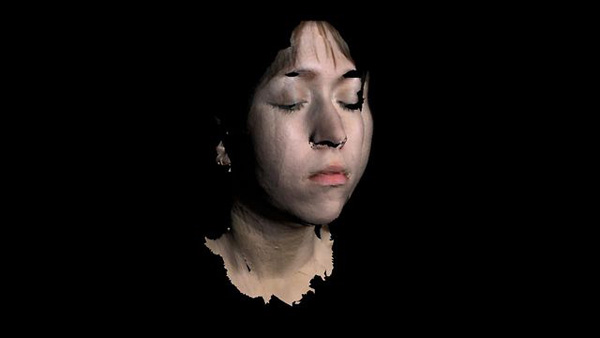
04302011 (2011) by Sophie Kahn is a collection of laser portraits of New Yorkers inspired by rotating 3-D models of people on large public screens in sci-fi movie scenes. The portraits appear incomplete and fragmented as a result of disruptions caused by the models’ movement and breathing during the scanning process, suggesting a metaphor of instability in our digitally mediated identities.

James Case-Leal’s Republic of Heaven (2010) presents a lyrical interpretation of the world in which we live. The piece illustrates a spiritual departure from the material world into “the next world” – that is fantastic and perhaps ideal – one which might be possible in the digital realm. It reflects human aspirations and a sense of endlessness, perhaps mirroring the experience in the world’s endless chain of Internet links.

Jason Bernagozzi’s The Presence of Something in its Absence (2008) illustrates a perceptual experience in a digital world. In this poetic universe, there is a sense of ‘getting lost in code’ or virtual worlds; perhaps a search for identity, perception and rhythm, covered in great expectations for the future.
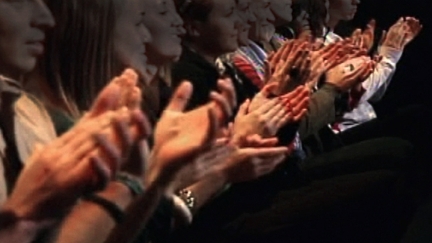
Venerations (Applause) (2009) by Caraballo-Farman questions the dictates of logic and free will. Why does an audience produce shared emotional states and erupt in collective applause, bound beyond reason? This ritual mirrors situations of collective behavior in a manipulative, commercial, and participatory culture, which is becoming increasingly complex and opaque.
Karolina Sobecka, Michael Greathouse, Sophie Kahn, James Case-Leal, and the artist team caraballo-farman, are 2011 Artists’ Fellowship recipient of the New York Foundation for the Arts (NYFA). Jason Bernagozzi is a 2011 Artists’ Fellowship finalist.
REVELATION
REVELATION: Jeremy Blake, Jenny Marketou, Yorgo Alexopoulos, Marty St. James
60:00
ARTISTS:
In the fall of 2011 the exhibition Revelation, in commemoration of 9/11, presented a collection of existential portraits and reflections on streams of realities that exist simultaneously in the contemporary world. Featured artists include Jeremy Blake, Jenny Marketou, Yorgo Alexopoulos, and Marty St. James. The artwork was balanced with a showcase of visionary programs that confront the world’s most pressing problems with solutions to bring about the Regeneration of society and the environment – The Buckminster Fuller Challenge, Green World Campaign, and the Ubuntu Education Center, Port Elizabeth, South Africa. Jeremy Blake and Yorgo Alexopoulos are presented courtesy of Kinz + Tillou Fine Art in New York.
Revelation Part 1 – featured the artwork of Jeremy Blake and Jenny Marketou which is juxtaposed as a dialog that brings to view beautiful images that are concealing inherent danger. Blake’s Chemical Sundown aims at LA’s fantasy of exceptionally colorful sunsets that are in reality ominously artificial and caused by pollution. In Marketou’s Levels of Disturbance, a revolving sphere intrudes over video footage of the natural landscape of Los Alamos filmed from an airplane, mesmerizes and subverts attention from the reality of its radioactive history.
Revelation Part 2 – Jeremy Blake’s Winchester Redux is part of his Winchester series that distills and abstracts American myths of violence and spiritual reconciliation. The dreamlike flow of images gives an abstract emotional tour of the fearful chambers of his subject’s mind. Marty St. James’ Oneiric enters inner dimensions and confines of the individual, and reconstructed reality is explored in The Invisible Man. Yorgo Alexopolous’ No Feeling is Final is an abstract narrative symbolizing the interconnection between mathematics, humans, nature and universe, the real and virtual. Blake’s “Station to Station: Indiglo Heights is the fifth in a series of five individual time-based paintings,representing an imaginary urban transportation system. ”Contemporary anxieties concerning chemical weaponry, global warming gasses and mysterious technologies were also kept well in mind while making this work,” Blake wrote, “as was the sensory excitement of travel and the hypnotic allure of bright, pulsating city lights.”
Video portraits from conflict zones and architecture hovering above earth –
The intimate video portraits of Marines in Afghanistan by Balazs Gardi bring real-life connection with the men serving in one of the most dangerous conflict zones in the world. The work was created as a project of Basetrack, a web-based reporting initiative supported with a grant from the Knight Foundation.
This contrasts with a world-view from outerspace in Kairos – an architectural design for a building to orbit the earth by Emanuel Pimenta, that is informed by Socrates (469-399BC): “Humans must rise above the Earth – to the top of the atmosphere and beyond – for only thus will he fully understand the world in which he lives.” Pimenta dedicated this video and sound artwork to his collaborators, John Cage, Merce Cunningham, and to the humanist concepts of Buckminster Fuller, Joseph Beuys and other visionaries.

Chemical Sundown, 2001, video still. Courtesy of
Kinz + Tillou Fine Art
JEREMY BLAKE, Chemical Sundown, 2001, Station to Station #5, 2001, Winchester Redux, 2004
Chemical Sundown, 2001
In the past few decades Los Angeles has outpaced New York City as the urban environment that best exemplifies the apocalyptic in American consciousness. One portentous prospect, global warming, is hinted at in the popular wisdom that LA sunsets are exceptionally colorful because the atmosphere surrounding the city is polluted. Despite the fact that today’s mass anxieties are often yesterday’s news, cliches surrounding a specific place sometimes hold interest for me because they indicate inter-subjective fantasy locations and/or events more compelling than their sources in reality.
Chemical Sundown is a time-based painting that combines architectural and abstract imagery, inspired by the legendary optical effects of LA’s tainted air. The piece begins with a graphic depiction of a horizon line that begins to radically change shape, indicating a landscape capable of liquefying without warning. Soon, images appear which portray a glamorous modernist structure, built on this land despite the inherent danger. This structure is equipped with sliding walls and large windows designed to let in natural light. The changing light, in combination with the smog, creates clouds of color that range from beautiful to ominously artificial. Technically, this work deliberately ignores certain restrictions on bright colors in the NTSC color system. Other “raw” elements are also consciously left visible. The intention is to enable something like the visual equivalent of the controlled distortion common in electronically produced music.
In one room of the structure a film loop is shown embedded in a set of monitors. The footage (from the film Casino Royale) shows a woman in a pink gown, standing on a pink spinning bed, enjoying a shower of feathers swirling around her. This image of unapologetic hedonism is used here as a sexy, phantom presence. I also like the subtle implication that the cycling footage might have a hidden, but specific effect on the function of the architecture around it. (I imagine this working in much the same way that-in the movies at least-a ray of light might activate the door of an ancient tomb.)
An oval shape is repeated throughout the piece. This shape is meant to recall the sun, the lenses of sunglasses, and is arranged in groups of two that resemble the number eight. The 8 shapes provide a visual link to an earlier and related series of works entitled “Bungalow 8″, which dealt with the glamour, decadence and ambiance of Hollywood’s mythic character.
Jeremy Blake, 2001
Courtesy of Kinz + Tillou Fine Art, New York
Station to Station, 2001
Station to Station is a series of five individual time-based paintings (digital animations on DVD) that have been conceived to work as discrete pieces, but also forms a coherent series or system that, when shown together, adds substantially to the meaning and the impact of each individual work. Although each work is multifaceted, the basic structure of the series is simple. The first, third, and fifth monitor of this five-screen series represent stations on an imaginary urban transportation system. The second and forth represent travel between these stations.
The space intersected and contained by this system is meticulously gridded off, entirely design-mediated, and one which changes in color and mood constantly. Distinctions between inside and outside, and near and far prove to be difficult to draw, and largely deceptive when they are drawn. Contemporary anxieties concerning chemical weaponry, global warming gasses, and mysterious technologies were also kept well in mind while making this work, as was the sensory excitement of travel and the hypnotic allure of bright, pulsating city lights. For much of this imagery and atmosphere I have drawn from daily life in New York, as well as memories of the smoggy vistas of Los Angeles, but a major inspiration for the for the design of the three stations comes from an element of the subway system in Tokyo.
On a trip to Tokyo several years ago I was struck by the design of a bank of coin operated storage lockers in a downtown subway station. This bank was relatively large (from my snapshots I’d estimate at least 12 feet wide and 7 feet high). The door of each locker had one small section of a large landscape photograph printed on it. When all the doors were closed, a large landscape was visible, and the overall effect when viewed from a distance effectively simulated the experience of looking out a window at an attractive view. More often than not however, unused lockers were left open, creating gaping black holes in sections of the bigger picture. The fact that this apparently deep space quickly proved itself to be both traumatically shallow and defined primarily by its utility struck me as definitively contemporary. Therefore, each of the stations in Station to Station is outfitted with one of these banks of lockers, as well as abstract elements that have been derived from its design. In this work abstraction is treated not as static and monumental, but as something that may set in and wear off like the effects of a drug-or that may appear and disappear like a mirage.
Another, more general source for this work is “The Power Broker,” Robert Caro’s excellent biography of urban planner Robert Moses. Caro describes Moses as a brilliant, corrupt, and almost unbelievably arrogant figure-and the planner to whom we owe many of the defining characteristics of the infrastructure in and around New York City. In his book Caro has crafted gripping descriptions of Moses blasting through bedrock and destroying neighborhoods to build the Cross-Bronx Expressway, and clearing slums only to reinforce their existence with monumental housing projects. The fact that one person, and therefore one person’s subjectivity, is the source for so much of what I had always assumed was the result of a gradual accumulation of projects by different planners struck me as disturbing. In the course of reading “The Power Broker”, I began to imagine Moses as the Darth Vader of New York aesthetics, subliminally telling generations well meaning New York artists who have been influenced by their surroundings what they might have suspected but least wanted to hear, “I am your father Luke…” This fantasy is obviously an exaggeration encouraged by some startling reading, but its true that Moses’ grim aesthetics still help to define what its like to travel through New York. Moses was generally pro automobile and anti-mass transit, so there is a deliberate irony in my naming a station after him.
At its inception, rail travel transformed the way in which space was perceived and the speed with which temporal and spatial information was processed. Each passenger with a view out of the window was provided with a framed, flattened, constantly shifting landscape. In a way that we now take for granted, each passenger had suddenly become the director of a non-narrative cinematic experience. Station to Station draws on this precedent as a foundation for its formal structure in order to better reference its own, relatively new space-altering potential as a completely subjective landscape created in a time-based medium and accessible through multiple simultaneous views. In general my work draws from both traditional painting and time-based media in order to create something new.
Jeremy Blake, 2001
Courtesy of Kinz + Tillou Fine Art, New York
Winchester Redux, 2004
The Winchester trilogy and Winchester Redux are inspired by my interest in the Winchester Mystery House in San Jose, California. The Mansion is an architectural wonder that Sarah Winchester, widow of the heir to the Winchester rifle fortune, constructed over the course of 38 years, beginning in the late 1800’s. After suffering the premature death of her child and then her husband, Winchester, informed by her deep belief in Spiritualism, concluded that the angry spirits of those struck down by her family’s guns had cursed her. An advisor agreed and suggested that she build an enormously large house–an endeavor that would both accommodate good spirits and ward off evil ones with the sounds of never ending construction. The result is an eccentric, sprawling 160-room mansion, well outfitted for the undead with staircases going nowhere, doorways leading out into open air several stories above ground, and miles of darkened hallways for the spirits to roam.
The Winchester films combine 8mm film footage, static 16mm shots of old photographs, hundreds of ink drawings, and intricate frame-by-frame digital retouching. They are meant to provide an abstract and emotional tour–not so much of the architecture, but of some of the more fearful chambers of Sarah Winchester’s mind. The abstract imagery represents supernatural activity, heightened by paranoiac glimpses of shadowy gunfighters, painterly gunshot wounds blossoming into Rorschach patterns, and a spectrum of images from Winchester rifle advertisements. The entire series is informed by the idea that the Victorian aesthetic (embodied by the Mansion’s architecture) and the psychedelic sensibility (referenced through hallucinatory manipulation of the film) are sympathetic opposites.
My interest in the Mansion is rooted in an understanding that the site is more than just a monument to one person’s eccentric preoccupation-it is the tangible outcome from a collision of social and historical narratives. The series ties together several mythic strands fundamental to an American national identity in an attempt to justify Winchester’s architectural free-for-all. The figure of the gunfighter facilitates spiritual regeneration through violence, and lawmen and outlaws are thus treated with reverent trepidation-as are the ghosts of their victims.
Beneath the dreamlike flow of images, the structure of the films is very deliberate. They first explore the exterior of the Winchester Mansion, and then reveal glimpses of the interior, with an emphasis on parts destroyed in the earthquake of 1906. Sarah Winchester chose not to repair certain damaged sections, preferring to build around them, as she imagined that the house’s resident spirits disapproved of these accommodations. The camera next zooms in on a cinema complex of three space-age movie theaters situated across the street: Century 21, Century 22, and Century 23, alluding to the fact that it is film, TV and the media that perpetuate the icon of the gunfighter. This is represented by richly layered montages of the Old West and pop-culture imagery, as well as art and film celebrities who appear as phantom stand-ins to embody the specters of the Cowboy and of Sarah Winchester herself.
The Winchester series distills and abstracts American myths of violence and spiritual reconciliation.
Jeremy Blake, 2004
Winchester Redux, courtesy of Creative Time and Kinz + Tillou Fine Art
Biography
JEREMY BLAKE (1971 – 2007)
Jeremy Blake was an artist of recognized accomplishment and promise. His artistic achievements and career were fast on the rise. He was considered influential and iconoclastic. Sadly, Blake committed suicide in July 2007 in New York City one week after his beloved companion of 12 years, Theresa Duncan, committed suicide–the reasons for which remain open only to conjecture.
Blake first garnered attention in the late 1990s with his large-scale, semi-abstract digital C-prints that rendered the appearance of being paintings and photographs, but were neither. He then began to animate sequences of such images to create continuously looping digital video works that emulated paintings and film, but were neither. His visually dense images often incorporated both abstract and representational expressions through the language of Modernism and voices of Film Noir. Blake’s aesthetically stylized works addressed a range of subjects from violence and terrorism to glamour and decadence, from metaphors of architectural spaces to profiles of cultural personifications.
Blake’s works have been exhibited internationally. They were included in three Whitney Biennials, are represented in twelve museum collections, and are a topic of dissertations and textbooks. He is widely acclaimed as a pioneer in merging the traditions of painting with a new digital world. He created hybrids of new media works, new genres, and a new kind of art experience. He made “paintings” that were digital prints and films that were “moving paintings”. He was an innovator who opened doors to how others will express themselves long into the future.
Blake continued to challenge our expectations, as well as his own. He dissolved the distinction between object and time-based art while combining abstraction and representation in fresh and exciting ways. He used the most eloquent of formal vocabularies to illustrate hidden stories, present cinematic portraits and portray social perspectives. He was a narrative abstractionist who embraced history, pop culture, biography and fiction, and he always made things to be beautiful. His works are seductive; his subjects are provocative; his meanings are profound.
Jeremy Blake opened our eyes and expanded our ideas as to what art can be and how we see and think about the world. His contributions will be forever remembered and his legacy everlasting.
Kinz + Tillou Fine Art, New York
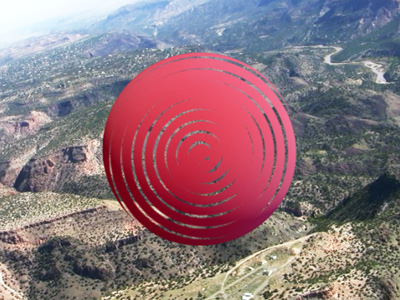

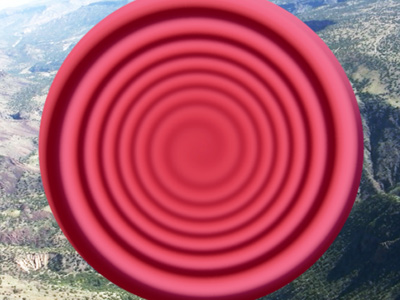
JENNY MARKETOU, Levels of Disturbance, 2009-2011
Single channel video projection, color and sound, loop
“We forget too soon the things we thought we could never forget.”… Jean Didion
Although we are all bombarded by seemingly endless amounts of imagery and “news”, I am convinced that we are also all suffering from information deprivation, and in a multiplicity of ways. While media conglomerates and government powers shield information from us continually – and spin the information that we are being fed – I think we are also all guilty of collectively forgetting our histories. Information is ignored even when we have access to it. Certain things are just too difficult to face. Government handouts, unregulated corporations, corporate takeovers of the media and of the government, industry’s devastation of the environment… These are very old stories. Why should these things surprise us when they continue to happen?
The material for video for Levels of Disturbance has been shot over a week’s period from an aerial view distance while I was flying over the town of Los Alamos and it was conceived during the period of my artist in residence at the Center of Contemporary Art in Santa Fe, New Mexico in the fall of 2009.
Los Alamos which currently stands as a national monument and a tourist attraction is still contaminated by the nuclear waste and by turbulent human emotions going back to the late 40’s when Los Alamos is the most secret city in the world; the home of the renowned scientific community, known as the laboratory of the Manhattan Project where a weapon of incredible power, the atomic bomb has been produced and tested.
The artists process starts during montage when all the recorded aerial views of the breathtaking landscapes has been edited frame by frame into a slide show and has been used as a backdrop over which is imposed a red round shape. The shape suggests the infinity symbol of planetary orbits and standardized cartographic representations and measuring principles used for all natural phenomena. The two layers cycle is assembled digitally in a continuous flow of rotations and transformations and takes their rhythm from the ambient soundtrack composed by the sound of the propeller of a plane. The constant red color ripples of the circle seems as a powerful way to create suspense and focuses viewer’s gaze as some form of surveillance on the surface of the image and intentionally abstracts and distorts any passage to the landscape, and information is intentionally fragmented, abstracted and distorted.
The reason I set up Levels of Disturbance this way is to test the rhetoric of cultural and historical amnesia in contemporary images. Amnesia forms a vast territory of disintegrating or disappeared information. In an effort to map this sea of mind my video Levels of Disturbance explores one of the major themes related to the loss of memory and history – the deliberate suppression of memory by a society, the loss, confusion, destruction of information or alteration of a culture’s record of itself; and it investigates how technological mediation produces specific qualities in the images which erase memory, create disorientation, influence knowledge.
Jenny Marketou, 2011
Biography
JENNY MARKETOU
Born in Athens, Greece, Jenny Marketou is a new media and old media artist based in New York City. Her work reaches the public through photography, web, public performances and interventions, video installations, single channel videos, design, teaching, lecturing and various forms of social actions. She has produced many internet and network projects, some highly recognized such as SmellBytes and taystes.net during her involvement with the net.art movement in 1998. Her work is based on creating open systems by modifying communication and mobile technologies and she is also developing work in the area of physical public performances. Jenny Marketou is intrigued by hidden information, being public and is unified by sympathy, fear and humor for the individual in the contemporary world of dense mediated communication, mobility, surveillance and social networking.
Marketou is currently working on her solo project Paperophanies which will be launched on October 8 , 2011 as part of Praxis projects at Atrium Museum in Vitoria in collaboration with local universities , community groups , artists and the Guggenheim in the Basque Country in Spain. Her public installation Red Eyed Sky Walkers/ SILVER Series is currently on view at Gate (ways): Art and Networked Culture, an exhibition at Kumu Art Museum in Tallinn, Estonia (Cultural Capital of Europe) commissioned Kumu Art Museum and by Goethe Institute.
Marketou’s work has been commissioned and exhibited internationally. Recently she has had solo exhibitions at (EMST) National Museum of Contemporary Art in Athens, Greece , the Contemporary Art Museum Reina Sophia in Madrid, Spain; Fondazione Claudio Buziol in Venice, Italy in collaboration with students from the Art and Design School in Treviso (IUAV).
Her work has also been featured at 54th Venice Biennial in Venice; Onassis Cultural Center, Athens, Greece; APEX Art, New York City; The Project Room for New Media and Performing Arts, Chelsea Art Museum, New York City; PULSE Art Fair, New York; Anita Beckers Gallery, Frankfurt/Main; the 3rd Biennial of Seville, Seville, Spain; KunsthalleBasel, Switzerland; Strozzina Center of Contemporary Art, Florence; Centre Pompidou, Paris; Kunstverein Ludwigshafen, Mannheim, Germany; The New Museum, New York City; Eyebeam, New York City; Rose Museum of Contemporary Art, Brandeis University, Boston; ZKM Center for New Media and Art, Karlsruhe, Germany, 2006; Queens Museum of Art, Queens, NY; Breeder Gallery in Athens, Greece; CornerHouse, Manchester, UK; Krannert Art Museum, Urbana-Champaign, Illinois; The Banff Center, Canada, among other venues. She represented Greece in the Biennial of Sao Paolo, Brazil and in Manifesta at Witte de With, Rotterdam.
Since 1995 Marketou’s work has been awarded grants and residencies NYSCA Grant, New York; Experimental TV Center Grant, Ithaca, NY; Artist in Residence, Center of Contemporary Art (CCA), Santa Fe, New Mexico; Ohio State Art Council Grant, Cleveland; Artist in Residence, Eyebeam, New York; Artist in Residence and Co-production at The Banff Center, Canada; OMI International Residency, New York among others.
Jenny Marketou holds an MFA from Pratt Institute in Brooklyn, New York and has taught at Cooper Union School of Art in New York City. She has lectured extensively in academic institutions and art centers around the world. She is the author of the book “ Great Longing: The Greek of Astoria, New York”, with photographs and interviews of first generation Greek immigrants who made home Astoria, Queens.
http://www.jennymarketou.com
http://jennymarketou.blogspot.com
Current projects:
Paperophanies” PRAXIS Projects, Artium Museum, Vitoria, Spain
Red Eyed Sky Walkers: Silver Series 2011, Kumu Art Museum, Tallinn, Estonia
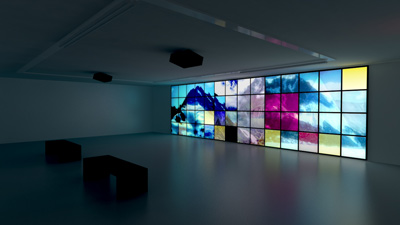
YORGO ALEXOPOULOS, No Feeling is Final, 2010
This work is a synchronized composite of two horizontally aligned high-definition video frames with a continuous looping duration of ten minutes. An animated grid of digitally manipulated paintings, photographs and graphics move across the screen. An abstract narrative unfolds, composed of archetypal images and symbolic shapes.
Our individual and collective connection to things larger than ourselves is the inspiration for this visual and audio orchestration. The enveloping experience invokes commonly held ideas and questions regarding ineffability and subjectivity as they relate to our understanding of nature and the universe. Intermixed with landscape images are the simple Euclidean geometries (circle, square, triangle) that have helped philosophers, artists, and scientists interpret and represent the complexities of the universe. A mountain becomes a triangle, and the moon a perfect circle.
The metaphoric “characters” in this animistic drama stride across the stage, assembling loosely as a collage of abstract shapes and their earthly counterparts, therein revealing the basic forms that we use to perceive the world. This places the supposed purity of nature against our projected emotions of its representation.
For example, the desert often symbolizes vast emptiness or the negation of landscape. From one point of view it is a place to retreat and find divine revelation. On the other hand, it is a symbol of spiritual sterility. In contrast, a garden is a place where nature is tamed and its beauty cultivated. As a symbol of perfection and ordered beauty, the garden is often an enclosed escape from ominous wilderness where death, disorder, and violence can lurk. Because nature is subdued and controlled in a garden, it is often taken to represent the conscious mind as opposed to the forest, which stands for the dark, tangled, rooted growth of the unconscious.
The pulsating matrix of No Feeling is Final organizes its visuals like a map; forming a topographical world with latitude and longitude lines unrelated to the actual proportions of the Sphere. Each square is a world within itself. All together they support each other collectively. In our fractal reality perfect shapes fit together like pieces of a puzzle, whereas in No Feeling Is Final, they fade into each other and share the same space, as if it were some other place where both the “real” and the constructs of our imagination co-exist peacefully.
Yorgo Alexopoulos, 2010
Biography
YORGO ALEXOPOULOS
Yorgo Alexopoulos is a New York-based artist best known for his innovative use of digital media and technology. His artistic approach is gleaned by fusing traditional media such as painting, photography, film and sculpture with digital media. He often creates experiential video installations and high definition flat screen pieces by syncing multiple monitors or projections. Alexopoulos’ artworks often touch upon transcendental themes. He uses animation software informed by techniques fine-tuned from earlier in his career as a visual effects animator in the motion graphics industry. He is a graduate of the School of the Art Institute of Chicago.
Website
Courtesy of Kinz + Tillou Fine Art, New York


MARTY ST. JAMES, Oneiric, 2001; The Invisible Man, 2007
These video artworks signify the human struggle to locate an inner sense of self and being, a recurring theme in the artist’s body of work. Oneiric enters inner dimensions and confines of the individual. The Invisible Man, explores a reconstructed reality, in a 3 channel digital video projection installation, excerpted and remixed here for the public screen platform. It is an Homage to H.G Wells’ book by the same name, the landscape paintings of Turner and Constable, Beuys with his hat, and Magritte with his notions of formal clothing elements in his men with Bowler hats. It is also a personal homage to the artist’s late brother. St. James films in South West of France and edits in London.
Biography
MARTY ST. JAMES
Existing somewhere between the moving and the static is an excellent description of the work of and intentions of artist St.James. Stepping, as if from one stone to another he has created artworks primarily in performance art, video art, photography and drawing. He describes it as exploring the physical, the electronic and the pencil equally.
‘a time based artist media artist straddling both modernist and post-modernist times..’
– Sue Hubbard The Independent Newspaper.
Tours of Europe and North America in the 1980’s with a suitcase full of props brought him recognition as an improvising based performance artist dealing with popular cultural issues and themes. These social based works were performed in galleries, festivals, ferries and shopping centres. Civic Monument a travelling living sculpture (1990 supported by the Art Angel Trust) saw the end of his live performance art works.
Forty of his video pieces have been archived by the British Film Institute in the UK including Mr and Mrs his first video work based on a television game show appearance and Metamorphosis (Headcake 1998). During the 1980’s a number of his video works were broadcast on national television including Timecode (Heartbeat 1988) shown in a number of countries worldwide.
The Video Portraits of the 1990’s are some of his best known works including The Swimmer an 11 monitor installation work in the collection of the National Portrait Gallery, London. These works ranged from miniature single monitor video objects to large multi-monitor installations.
He has represented Britain abroad in a number of exhibitions, performance art events, video screenings and festivals via the British Council and Arts Council, including, Electronically Yours at the Metropolitan Museum of Photography in Tokyo (1998) and Artec Nagoya, Japan (1995). During 2000 his year- long inter-active digital work Picture Yourself showed at the Scottish National Galleries celebrating the millennium with the public able to see themselves projected on the museum walls. In 2000 his Boy / Girl video diptych showed at the National Portrait Gallery in London, Painting the Century, 101 Portrait Masterpieces from the 20th century including Picasso, Freud, Bacon, Warhol, Munch etc…
Running through St.James’ works there has been a sense of self-portraiture or the portraiture of others. In his recent shows in Moscow, The Journey of St Maurin (2002) and New York Somewhere or Between (2005) there has been a sense of the artist involved in a struggle to locate an inner sense of self and being. And a serious attempt to try and convey this to audience rather than ignore their presence or pander to our obvious emotions. Too much video art has tended to rely on the obvious, cheap tricks and gimmicks; St James has begun a process of real engagement between self, medium and viewer.
On the subject of his drawings St.James describes his paper works as ‘thinking actions’, things that land and are fought onto the paper via thinking.
…. Marty St.James believes that art only matters if the artist has something important to say, that his or her work is not simply an item of commercial transaction. His is an Apollonian discourse rather than a Dionysian one. For him art is a way of thinking in the visual rather than the making of a heroic statement or precious object. He is in tune with Bachelard’s notion that the embodiment of knowledge exists in the action of making, rather than in the object of the finished piece. His intention is to investigate “the stringing together of moments in frame type form to explore surface and time.”
– Sue Hubbard Arts Editor The Independent Newspaper, London


 Back to Homepage
Back to Homepage

